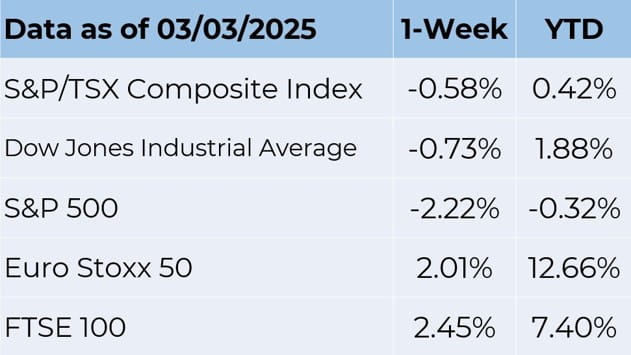Weekly Market Commentary March 11 2025
Canada’s Economy on the Brink of Recession
Canada's economy is likely to enter into a recession, following the U.S. imposing a 25 per cent tariff on its exports. That’s the sentiment echoed by Desjardins’ deputy chief economist Randall Bartlett. According to the analyst, it would be challenging for the economy not to fall into recession within a few months of the tariffs coming into play.
“Ultimately, retaliatory tariffs are just going to exacerbate that and also lead to higher inflation, so it will provide a bit of a challenge for the Bank of Canada in terms of contending with a negative shock to gross domestic product (GDP) and at the same time, upward pressure on inflation,” he said.
In addition to a range of possible non-tariff responses that are carefully crafted to harm U.S. companies, Canada is certain to impose retaliatory tariffs, which could further harm Canadian consumers and, consequently, the domestic economy.
Bartlett joins several economists who insist that the tariff war between the U.S. and Canada will only fuel inflationary pressures at a time when central banks have cut interest rates significantly. When the United States imposes tariffs, the Canadian dollar is affected, which eventually affects items imported from the United States. As a result, domestic inflation is somewhat raised.
The economists expect the tariff war to be a net negative for both the U.S. and the Canadian economies. Nevertheless, they will remain popular on both sides of the aisle as the countries look to trim down their trade deficits.
The tariffs could continue as planned and be lifted after a short time, or could end up having a significant impact on the economy and markets. Indeed, the high taxes will have disastrous effects on the Canadian economy, which is still recovering, making the risk of a recession evident and imminent. Any plans the Bank of Canada may have to implement a rate cut freeze would be upended by such an event, which might call for even more drastic reductions to their policy rates.
Canadian policymakers have had to balance a tightrope as they attempt to control inflation, slow down the rate of interest rate reductions, and support the economy and job market. However, Canada's broad-based tariffs and comparable countermeasures against U.S. imports make it extremely unlikely that Canada's economic fortunes will turn around.
Analysts emphasize that rather than affecting the overall index, the new taxes would have an effect on stocks, in particular, industries. Sectors at most risk from increased tariffs include IT, hardware and equipment, autos, and subsets of consumers, according to strategists in the Morgan Stanley note.
The impact of the trade tariffs are already being felt in the equity market. Canada's main stock index, the Toronto Stock Exchange, suffered its biggest drop since December. The index fell by about 1.54 per cent as energy and technology stocks led broad-based declines in response to the U.S. tariffs. The index is on the brink of dropping below the $25,000 level amid deep sell-offs.
Financial markets were rocked by the prospect of new economic barriers in North America, after Trump stated that neither Mexico nor Canada could stop 25 per cent tariffs from going into effect on Tuesday. In February, Canadian manufacturing activity shrank for the first time in six months, as businesses became the most pessimistic since the COVID-19 pandemic began due to an uncertain trade outlook.
The Markets
Is it supposed to be doing that?
At the end of last year, economists believed the chance of a recession in 2025 was relatively low. In December, economist Torsten Sløk wrote, “The outlook for the U.S. economy remains strong with no signs of a major slowdown going into 2025.”
The economy has not been performing as expected, though. “The U.S. Citi Economic Surprise Index, which tracks the difference between economic data and expectations, has fallen to its lowest level in almost six months. The index rises when the surprises are favorable, so the decline means the data are showing a less robust U.S. economy than expected,” reported Jacob Sonenshine of Barron’s.
One surprising piece of data is the slump in U.S. consumer confidence.
The University of Michigan Consumer Sentiment Survey reported that consumers have become less optimistic. Sentiment declined by 9.8 per cent from January to February. The Conference Board Consumer Confidence Index showed a 7.0 per cent drop over the same period.
“The decrease was unanimous across groups by age, income, and wealth…Year-ahead inflation expectations jumped up from 3.3 [per cent] last month to 4.3 [per cent] this month, the highest reading since November 2023 and marking two consecutive months of unusually large increases,” reported Surveys of Consumers Director Joanne Hsu.
The slump in sentiment is concerning, because consumer spending is the primary driver of U.S. economic growth – accounting for about two-thirds of gross domestic product (GDP), which is the value of all goods and services produced in the country over a certain period. In general, when consumers are uneasy, spending tends to slow and so does economic growth.
Currently, one consumer group has more influence than others do.
When analysts took a closer look at consumer spending, they found a growing wealth gap. “The wealthiest 10 per cent of American households
—those making more than $250,000 a year, roughly—are now responsible for half of all U.S. consumer spending and at least a third of the country’s gross domestic product,” reported Amanda Mull of Bloomberg. “In the 1990s, spending by top-decile earners usually constituted a third or so of annual consumer spending overall. Now, their spending constitutes the largest share of the consumer economy in data going back to 1989.”
Last Friday, we learned that consumer spending declined 0.5 per cent month to month, after inflation, in January. It was the biggest monthly decline in almost four years. “U.S. consumers unexpectedly pulled back on spending on goods like cars in January amid extreme winter weather, and a slowdown in services, if sustained, may raise concerns about the resilience of the economy,” reported Augusta Saraiva of Bloomberg.
While we’ve seen a lot of uncertainty and some softer-than-expected economic data, the likelihood of a recession over the next 12 months remains low. Economists polled by The Wall Street Journal’s Economic Forecasting Survey put the odds at 22 per cent, reported Andy Serwer of Barron’s.
No matter where the economy is headed, investors can manage the risks associated with market volatility through asset allocation and diversification. If you have not reviewed your portfolio recently, this is a good time to make sure your asset allocation is appropriate for your financial goals and risk tolerance. If you would like help, let us know.
Last week, the Dow Jones Industrial Average moved higher, while then Standard & Poor’s 500 and Nasdaq Composite Indexes moved lower. Treasuries rallied and the yield on the benchmark 10-year U.S. Treasury moved lower over the week.

Source: FactSet
Are You Bunching?
The Tax Cuts and Jobs Act (TCJA) introduced a higher standard deduction –$15,000 for single filers and $30,000 for people who are married and filing jointly in 2025. While the higher deduction was beneficial to many taxpayers, those who are near the cutoff for itemizing may employ an approach known as “bunching”, which makes it possible for taxpayers to itemize every other year, reported Adam Nash of Kiplinger’s.
Here’s how it works: taxpayers condense two years of tax-deductible expenses into a single tax year. Then, they itemize taxes for that year. In general, three types of expenses can be bunched. They include:
Charitable gifts. Some people choose to bunch charitable gifts into a single year by donating in January and then again in December. This increases the amount that can be itemized in a single year. There are other approaches that can help maximize charitable contributions into a single year, as well.
Medical expenses. Taxpayers can deduct qualified healthcare costs that are not reimbursed, as long as the amount exceeds 7.5 per cent of their adjusted gross income. So, when you know a big medical expense is ahead, if it is possible, plan the procedure for a year when you are itemizing.
Property taxes. If a municipality allows it, homeowners can make the previous year’s property tax payment in January and make the current year’s property tax payment in December. Currently, there is a $10,000 cap on state and local government taxes (SALT), which include property taxes, reported the Tax Foundation.
Some provisions of the TCJA are set to expire at the end of this year, including the cap on SALT. The administration has yet to decide how SALT deductibility will be modified. The options under consideration include:
- Repealing the SALT deduction, which would raise $1 trillion over 10 years.
- Making the $10,000 cap permanent and doubling it for married couples.
- Raising the cap to $15,000 for individuals and $30,000 for married couples.
- Eliminating income and sales tax deductibility while keeping property tax deductibility.
- Eliminating the SALT deduction for businesses.
This information is not intended as tax, legal or accounting advice. It is offered for informational purposes only. Talk with a tax professional and your financial advisor before taking action.
Weekly Focus – Think About It
“Normal is an illusion. What is normal for the spider is chaos for the fly.”
~ Charles Addams, Cartoonist
Best regards,
Eric Muir
B.Comm (Hons. Finance), CIM®, FCSI
Senior Portfolio Manager
Derek Lacroix
BBA, CIM®, CFP®
Associate Portfolio Manager

P.S. Please feel free to forward this commentary to family, friends or colleagues. If you would like us to add them to the list, please reply to this email with their email address and we will ask for their permission to be added.
Disclaimer:
Information in this article is from sources believed to be reliable, however, we cannot represent that it is accurate or complete. It is provided as a general source of information and should not be considered personal investment advice or solicitation to buy or sell securities. The views are those of the author, Eric Muir and Derek Lacroix and not necessarily those of Raymond James Ltd. Investors considering any investment should consult with their Investment Advisor to ensure that it is suitable for the investor’s circumstances and risk tolerance before making any investment decision. Raymond James Ltd. is a Member Canadian Investor Protection Fund.

